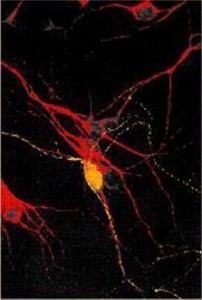Contributed by Douglas A. Lappi, Ph.D., President/Chief Scientific Officer, Advanced Targeting Systems, San Diego, CA
Substance P-Saporin (SP-SAP), ATS’s patented conjugate being developed for cancer pain therapy, has attracted a considerable amount of attention recently. Back-to-back publications, a press release and editorial were featured in the November issue of the journal Anesthesiology.
The first article, by Wiese et al.,[1] described the FDA-required intrathecal SP-SAP safety study in the dog. The authors concluded that intrathecal 15-µg SP-SAP reduced dorsal, but not ventral, neurokinin 1 receptor-positive (NK1r, the receptor for substance P) neurons at the spinal level of delivery with minimal side effects, whereas 150-µg SP-SAP resulted in motor neuron toxicity. Immunohistochemistry using a new NK1r antibody was correlated with in situ hybridization, and showed equality of identification on NK1r-expressing neurons.
The second study was in dog cancer pain performed by Brown and Agnello [2] at the University of Pennsylvania that showed, as the title states, “Intrathecal substance P-saporin in the dog: efficacy in bone cancer pain.” Companion (pet) dogs were randomized into a group that was going through normal pain management and a group that was treated with normal pain management, but received SP-SAP. Owners were kept in consult and the primary endpoint was measured as when the owners requested more pain pharmaceutical (dog activity, pain scores, and videography data were also collected). There was a significant difference between the two groups: more dogs in the control group that did not receive SP-SAP (74%) required unblinding and adjustment in analgesic protocol or euthanasia within 6 weeks of randomization than dogs that were treated with SP-SAP (24%; P<0.001).
The editorial comment by Hayashida [3] discusses aspects of the NK1r approach. Substance P has long been known to be important in normal pain transmission, but in the late 90’s, its receptor in the spinal cord began to be implicated in pathological pain. Substance P antagonists did not provide relief in human trials, so, Hayashida asks, why then would elimination of NK1r–expressing spinal neurons work? It is suggested that blockade of only one type of receptor is not sufficient, because of all the other neurotransmitters of pain (CGRP and glutamate, for instance) that still function on the pathology-producing neurons. Of great importance is that removal of NK1r-positive neurons removes the pathology of chronic pain, but there are other cells functioning on the input of other transmitters that allow for continued perception of normal acute pain.
The Food and Drug Administration has now allowed the use of SP-SAP in clinical trial. The patient population will be terminal cancer patients in pain that is refractory to opioids, a needy population indeed. The clinical trial will occur at the University of Texas Southwestern Medical Center in Dallas, under the direction of Dr. Carl Noe of the Department of Anesthesiology and Pain Management and sponsored by Dr. Arthur Frankel of UTSW’s Simmons Comprehensive Cancer Center. Dr. Frankel is a leading expert in the use of targeted toxins in humans. As Dr. Hayashida states: “We are looking forward to results of this clinical study.”

References: (back to top)
- Wiese AJ, Rathbun M, Butt MT et al. Intrathecal substance P-saporin in the dog: distribution, safety, and spinal neurokinin-1 receptor ablation. Anesthesiology. 2013;119:1163-1177.
- Brown DC, Agnello K. Intrathecal substance P-saporin in the dog: efficacy in bone cancer pain. Anesthesiology. 2013;119:1178-1185.
- Hayashida K. Substance P-saporin for bone cancer pain in dogs: can man’s best friend solve the lost in translation problem in analgesic development? Anesthesiology. 2013;119:999-1000.
